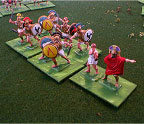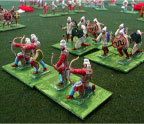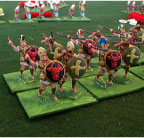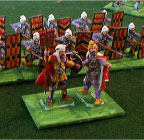 The
Battle of Marathon
The
Battle of MarathonFast Play Rules For Students
 The
Battle of Marathon
The
Battle of MarathonHistorical Background: The mighty Persian Empire was more than
a little annoyed when the Greeks encouraged the Ionians to revolt.
After crushing the revolt King Darius decided to punish the upstarts.
In 490 BC he led an army of over 40,000 soldiers into Greece.
There they faced a force of 10,000 Athenians on the plains of
Marathon. The Athenians surprised the Persians by charging them.
The strategy worked, and they routed the much larger force, driving
them into the sea. This battle was recreated twice for my students
in grades 6 - 8. It was a good choice for the first battle of
the school year since it was strictly an infantry fight.
 Battle
1: Our first recreation
of the Battle of Marathon included many rookie generals. The Greek
attack got off to a slow start, particularly on the right flank.
This allowed the Persians to pick apart the Greek army, starting
on left flank where General S. led the way. The game seemed headed
for a decisive Persian victory until General W. spotted a chance
for glory. She rushed her hoplites into battle with the Persian
Immortals. After some ferocious fighting the Immortals were broken,
and King Darius was wounded and carried from the field. The Persians
won a tactical victory, but the invasion of Greece was checked.
General M. earned MVP honors for his excellent work leading the
Persian center.
Battle
1: Our first recreation
of the Battle of Marathon included many rookie generals. The Greek
attack got off to a slow start, particularly on the right flank.
This allowed the Persians to pick apart the Greek army, starting
on left flank where General S. led the way. The game seemed headed
for a decisive Persian victory until General W. spotted a chance
for glory. She rushed her hoplites into battle with the Persian
Immortals. After some ferocious fighting the Immortals were broken,
and King Darius was wounded and carried from the field. The Persians
won a tactical victory, but the invasion of Greece was checked.
General M. earned MVP honors for his excellent work leading the
Persian center.
Battle 2: The Greek generals in battle two were determined to reproduce the victory of their historical counterparts. General P. charged the Persians and achieved a breakthrough, isolating the Persian right flank. He methodically demolished the Persian infantry, but General B. went down fighting. On the other flank General Br. and her Persians were taking the fight to the enemy. Her Immortals broke the Greek left and turned towards the center to roll up the line. The Greeks did the same on the opposite flank and the stage was set for the two forces to meet in the middle. General Z., arriving in the nick of time with Greek reinforcements, tipped the balance. Her men slammed into the Immortals, dealing them a heavy blow. This battle was a narrow Greek victory.
The Armies: The Greek and Persian armies were built from the Italieri sets of 1/72 scale plastic figures (5 boxes of each) mounted two per base (1.5" X 1"). Skirmishers were in single rank lines (3-6 stands), and formed infantry were in double rank lines (6-10 stands). There were five Generals on each side. Some of the Greek javelin skirmishers were used on the Persian side. All Persians except the javelin and sling skirmishers are assumed to have bows. Persians with large rectangular shields were classified as heavy infantry, and ten stands of these were Immortals. Persians holding bows, slings, or javelins were treated as skirmishers, all the rest were regular infantry. All Greek infantry were treated the same except for their skirmishers (figures with slings, javelins, or bows). Here are some paper soldiers you can print and use

|
Greek (stands) 5 Commanders 74 Infantry 5 Javelin Skirmishers 12 Archer Skirmishers 5 Sling Skirmishers |
Persians (stands) 5 Commanders 10 Immortals 23 Heavy Infantry 25 Regular Infantry 23 Javelin Skirmishers 25 Archer Skirmishers |
Sequence of Play:
1. Greeks Move
2. Greeks Shoot
3. Persians Move
4. Persians Shoot
5. Charge into Melee
6. Melee
 Movement: All units move 6". On turn one any
Greek unit may make a double move. Skirmish units may move in
any direction. Formed units are limited to wheels and obliques
of 45 degrees.
Movement: All units move 6". On turn one any
Greek unit may make a double move. Skirmish units may move in
any direction. Formed units are limited to wheels and obliques
of 45 degrees.
Shooting: Skirmishers and formed Persian infantry are allowed to shoot. Roll 1D6 for each stand in range. Every 6 is a hit and one enemy stand is removed. If any part of a unit is in range the entire unit may fire. Units that are engaged in melee may not fire, and may not be targeted.
Charge into Melee: Both sides may charge into melee. This is the only way to get into hand-to-hand fighting. Units may charge up to 6", but may only move if they can reach an enemy unit.
Melee: Each side rolls 1D6 for each stand in the fight. The Close Combat table shows the number needed to score hits. Remove one enemy stand for every hit. Both sides roll simultaneously. If both units still have stands left they remain engaged and fight again next turn.
 Last
Stand: If a unit is reduced
to one stand this last stand is removed immediately.
Last
Stand: If a unit is reduced
to one stand this last stand is removed immediately.
Generals: Generals may not be targeted individually. If they are attached to a unit they count as an extra stand in melee (but not shooting). If the unit they are attached to loses stands in melee roll 1D6. If the roll is a 6 then the General is eliminated.
Resources: The article "The Battle of Marathon, 490 BC" written by Ernest Mortimer was very useful. It was originally published in Battlefields magazine (Vol. 1, Issue 3, Feb. 1996) but I found it on Magweb. Mr. Mortimer's article includes historical background, a map, and other helpful information and suggestions for wargaming this battle.

|
|
|